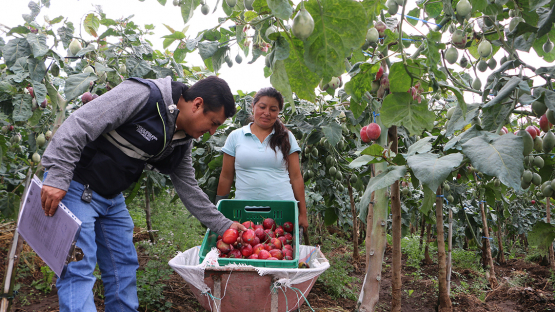Ecuador, one of the largest producers of tropical fruit in the Western Hemisphere, is adding non-traditional fruits to its export portfolio as a result of successfully fighting off the Mediterranean fruit fly with the help of nuclear techniques. After receiving technical assistance from the IAEA, in partnership with the Food and Agriculture Organization of the United Nations (FAO), to use – along with other methods – the Sterile Insect Technique (SIT) to control the flies, farmers are now shipping golden berries, dragon fruit and tree tomatoes to markets in the United States, Latin America and the European Union.
“The completion of the project will directly contribute to improving the livelihood of fruit producers in Ecuador by reducing the damage caused by fruit flies and increasing production for external markets,” said Rodrigo Salas, Head of the Undersecretariat for Nuclear Control and Applications.
Mediterranean fruit fly is one of the most destructive agricultural pests. Its larvae feed on the pulp of host fruits, making the fruit inedible. Due to its ability to easily adapt to different climates and the wide range of fruits and vegetables it infests, many importing countries have quarantine restrictions in place for fruits coming from areas where the fruit fly is well established – in order to protect their own orchards from the pests. Fruits can ripen and rot during the quarantine period, so this measure makes it difficult and costly for producers to reach foreign markets, limiting their export-led growth opportunities.
Ecuador has implemented a fruit fly pest control scheme based on an integrated pest management (IPM) programme including SIT, within the National Fruit Fly Management Project (NFFMP), which was supported by the IAEA and the FAO. The IPM is an effective and environment‑friendly pest control approach for crop production and protection that combines different management strategies and practices to effectively reduce pest damage, produce healthy crops and minimize the use of pesticides. This approach enables an increase of fruit and vegetable quality and production and facilitates international trade. In Ecuador, SIT was incorporated into the IPM approach in 2018.
“The area under NFFMP, where these non-traditional fruits are grown, covers over 35 000 hectares of commercial fruit production. Its significant reduction of fruit fly damage resulted in increased yields,” said Patricio Almeida, Executive Director of Plant Health Control in the Ecuadorian Agency for Regulation and Control of Plant and Animal Health (AGROCALIDAD). “As a result of integrated methods including SIT to suppress the fruit fly population, last year’s exports to the United States of these three fruits reached USD 22 million. In addition, the agricultural sector benefited from direct and indirect jobs that have been created along the production and export chain.”








